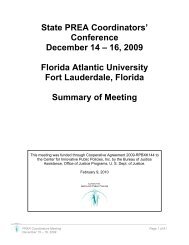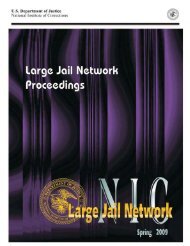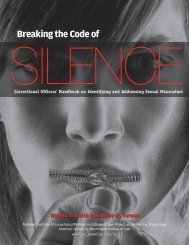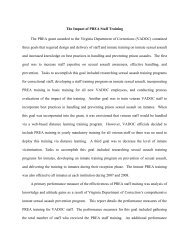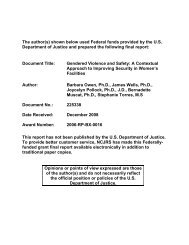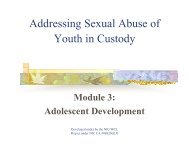Sexual Assault and Coercion Among Incarcerated Women Prisoners
Sexual Assault and Coercion Among Incarcerated Women Prisoners
Sexual Assault and Coercion Among Incarcerated Women Prisoners
- No tags were found...
Create successful ePaper yourself
Turn your PDF publications into a flip-book with our unique Google optimized e-Paper software.
The Prison Journalhttp://tpj.sagepub.com<strong>Sexual</strong> <strong>Assault</strong> <strong>and</strong> <strong>Coercion</strong> <strong>Among</strong> <strong>Incarcerated</strong> <strong>Women</strong> <strong>Prisoners</strong>: Excerpts From Prison LettersLeanne Fiftal AlaridThe Prison Journal 2000; 80; 391The online version of this article can be found at:http://tpj.sagepub.com/cgi/content/abstract/80/4/391Published by:http://www.sagepublications.comOn behalf of:Pennsylvania Prison SocietyAdditional services <strong>and</strong> information for The Prison Journal can be found at:Email Alerts: http://tpj.sagepub.com/cgi/alertsSubscriptions: http://tpj.sagepub.com/subscriptionsReprints: http://www.sagepub.com/journalsReprints.navPermissions: http://www.sagepub.com/journalsPermissions.navDownloaded from http://tpj.sagepub.com at AMERICAN UNIV LIBRARY on February 7, 2007© 2000 SAGE Publications. All rights reserved. Not for commercial use or unauthorized distribution.
392 THE PRISON JOURNAL / December 2000Previous lines of inquiry have focused either on sexual assault in the community(e.g., Bevacqua, 2000; Odem & Clay-Warner, 1998; Russell, 1984;Schwartz & Dekeseredy, 1997; Scully, 1990; Searles & Berger, 1995;Stanko, 1985) or male sexual assault inside male correctional institutions(e.g., Chonco, 1989; Cotton & Groth, 1982; Dumond, 1992; Eigenberg, 1989;Groth & Burgess, 1980; Jones & Schmid, 1989; Lockwood, 1985; Nacci &Kane, 1983, 1984; Saum, Surratt, Inciardi, & Bennett, 1995; Smith & Batiuk,1989; Tewksbury, 1989a, 1989b; Wooden & Parker, 1982). Both bodies ofliterature have ignored the prevalence <strong>and</strong> nature of sexual assault of incarceratedwomen.Academic experts in the area of female prisoner subcultures have onlyrecently acknowledged the possibility of female prisoner sexual assault(Bowker, 1981, 1982; Pollock-Byrne, 1990). Since the 1960s, previous studieshave found that many women prisoners participate consensually in playfamilies, intimate (nonsexual) dyads, <strong>and</strong> /or same-sex couple relationships(for a review of these studies, see Alarid, 1996). Most recently, Owen (1998)described involvement in play families <strong>and</strong> nonsexual friendships as a way toavoid “the mix.” The mix is defined as “any behavior that can bring trouble<strong>and</strong> conflict with staff <strong>and</strong> other prisoners,” which includes reduction of goodtime, restriction of privileges, or solitary confinement (Owen, 1998, p. 179).The three overlapping behaviors of the mix that most often led to troublewere involvement in homosexuality (“playing around”), drugs, <strong>and</strong> fighting.Most women interviewed by Owen did not admit to currently being in themix, only that they used to be involved or that they strongly advised stayingout of the mix. Exploitative relationships of an economical <strong>and</strong>/or emotionalnature were found to exist among women prisoners involved in the mix.However, there was little mention of sexual coercion <strong>and</strong> sexual assault associatedwith the “homosexual mix” (Owen, 1998).Outside of academic circles, increased attention has been paid to femaleoffenders who were sexually coerced or sexually assaulted by correctionalstaff (Amnesty International, 1999; APBnews.com, October 10, 1999; HumanRights Watch <strong>Women</strong>’s Rights Project, 1996; Smith, 1998; U.S. GeneralAccounting Office, 1999). <strong>Women</strong> prisoners are more likely to be sexuallyabused by correctional staff than are men prisoners (Donaldson, Dumond,Knopp, Struckman-Johnson, & Thompson, 1995). 1REVIEW OF THE LITERATUREThere are few existing studies, however, that address the prevalence <strong>and</strong>nature of sexual coercion <strong>and</strong> sexual assault of women offenders by otherDownloaded from http://tpj.sagepub.com at AMERICAN UNIV LIBRARY on February 7, 2007© 2000 SAGE Publications. All rights reserved. Not for commercial use or unauthorized distribution.
Alarid / SEXUAL ASSAULT AND COERCION 393incarcerated women. Two known studies were conducted by Cindy <strong>and</strong> DaveStruckman-Johnson in 1994 <strong>and</strong> 1998. The first study was conducted statewidein three men’s prisons <strong>and</strong> one female prison in Nebraska. The studyfound, via anonymous mail surveys, that 22.0% of men <strong>and</strong> 7.7% of womenreported that they experienced being “pressured or forced into sexual contactin a state prison facility” (Struckman-Johnson, Struckman-Johnson, Rucker,Bumby, & Donaldson, 1996, p. 74). 2 Of this number, only 29% of prisonersactually reported the incident to prison staff.A follow-up study was conducted in 1998 with 2,051 inmates <strong>and</strong> 518staff members at seven men’s prisons <strong>and</strong> three female prison units in othermidwestern states. The researchers found that the sexual coercion ratesreported by female inmates (those who reported at least one incident of sexualcoercion) varied among the three facilities: at 6%, 8%, <strong>and</strong> 19%(Struckman-Johnson & Struckman-Johnson, 1999, 2000). A second majorfinding was that between 55% <strong>and</strong> 80% of all sexual coercion in the threewomen’s units was committed by other women offenders, which is notablymore than that committed by correctional staff. Incidents described by thewomen offenders were defined <strong>and</strong> classified by the researchers. The sexualcoercion ranged from “pressure tactics” <strong>and</strong> genital touching to “force tactics”such as gang rape. Rape rates for women varied from 0% to 5% of thefemale offender population. Thus, most of the sexual coercion incidents werecommitted by other women offenders who fondled, seduced, or somehowpressured women inmates into oral <strong>and</strong>/or vaginal sex. These studies suggestthat sexual coercion rates of women prisoners varied by institution. Institutionalfactors included institutional size, housing type, <strong>and</strong> type of of- fender.Female institutions that were larger, had barracks or dorm-style housing, <strong>and</strong>housed offenders who were convicted of crimes against persons were morelikely to have higher rates of sexual coercion (Struckman-Johnson &Struckman-Johnson, 1999, 2000).METHOD<strong>Sexual</strong> misconduct among women inmates is particularly sensitive <strong>and</strong>difficult to study by outside researchers. Barriers to studying prison sexualcoercion <strong>and</strong> assault include inmates’ fears of the subculture, which prohibitsoffenders from disclosing misconduct by other inmates, the stigma of admittinginvolvement in the mix, lack of sensitivity from correctional officers, aresearcher’s limited institutional access, <strong>and</strong> resistance from prison administrators(Alarid, 1999; Eigenberg, 1989; Struckman-Johnson et al., 1996).Downloaded from http://tpj.sagepub.com at AMERICAN UNIV LIBRARY on February 7, 2007© 2000 SAGE Publications. All rights reserved. Not for commercial use or unauthorized distribution.
394 THE PRISON JOURNAL / December 2000The present research attempts to overcome some of these barriers by usinga qualitative case study approach to examine situations <strong>and</strong> behaviors underlyingsexual coercion <strong>and</strong> sexual assault among incarcerated women. Surveyswere initially disseminated to women in a large urban county jail in theSouth. The surveys asked women about a variety of attitudes <strong>and</strong> behaviorsrelative to the institutional subculture, the inmate code, play families, <strong>and</strong>sexual <strong>and</strong> economic behaviors (see Alarid, 1996, for detailed methodology).The survey data unexpectedly uncovered information that suggested thatsexual harassment <strong>and</strong> sexual coercion were present among women offendersin the jail. To further investigate this question, a r<strong>and</strong>om group of 25women offenders who had previously participated in the survey were askedto mail back additional information on sexual coercion. Contact with most ofthe women was eventually lost as they were transferred or released from jail.One woman, Velmarine, 3 maintained weekly contact through the mail for 5years, as she transferred between four or five different female units.Velmarine conducted observations of all aspects of the prison subculture <strong>and</strong>recorded them in written letters she mailed on a weekly basis. Velmarine is a41-year-old African American mother of three children, who is serving a25-year prison term for her third felony conviction. Although Velmarine hasbeen attending college <strong>and</strong> trying to keep to herself, she has admittedinvolvement in the mix. Velmarine detailed her own experiences of sexualcoercion <strong>and</strong> rape, as well as observations of others inside various prisonunits as they occurred. These experiences <strong>and</strong> observations were later indexedby the author according to certain themes that emerged <strong>and</strong> compared tothe existing literature.In this study, sexual assault is distinct from the definition of sexual coercion.<strong>Sexual</strong> assault is forced sex, <strong>and</strong> it ranges from unwanted genital touchingto oral, vaginal, <strong>and</strong>/or anal sex. <strong>Sexual</strong> coercion is pressuring anotherto have sex, ranging from verbal harassment to extortion to obtain sex(Struckman-Johnson & Struckman-Johnson, 1999, 2000).FINDINGSThe data indicate an association between involvement in the mix <strong>and</strong> sexualcoercion, in that the chances of sexual coercion <strong>and</strong> sexual assault seem toincrease during the time women are involved in the mix. Although manywomen are approached for sex or sexually harassed when they first come toprison, the pressure eventually subsides for unaffiliated women or “prisonChristians” who “don’t play.” However, the vast majority (75% to 80%) ofDownloaded from http://tpj.sagepub.com at AMERICAN UNIV LIBRARY on February 7, 2007© 2000 SAGE Publications. All rights reserved. Not for commercial use or unauthorized distribution.
Alarid / SEXUAL ASSAULT AND COERCION 395women in jails <strong>and</strong> prisons have been or are currently “in the homosexualmix,” in that they experiment with, or are involved in, coupling or relationshipsthat include sexual favors. Many of these women are involved in bothplay families <strong>and</strong> sexual liaisons. <strong>Women</strong> of all races <strong>and</strong> ethnic backgroundswho are involved in sexual liaisons most often prefer the “femme” 4role,whereas the outnumbered “stud” 5role is occupied primarily by AfricanAmerican women. Identified lesbians are obligated to play the stud rolebecause most prisons have a low supply of studs compared with the highnumber of femmes.Four themes emerged from the data of observations <strong>and</strong> experiences, relativeto sexual coercion <strong>and</strong> sexual assault among women offenders. Thethemes were (a) apathy toward sexual coercion <strong>and</strong> sexual assault, (b) the“jailhouse turnout femme” as the sexual aggressor, (c) insight to one rape situation,<strong>and</strong> (d) institutional factors contributing to sexual coercion.APATHY TOWARD SEXUAL COERCION AND SEXUAL ASSAULTThe data excerpted from the letters indicate first that the official (reported)sexual assault rate among women prisoners is fairly low in women’s prisons.In other words, sexual assault occurs between prisoners, but it is not reported.The reasons for the low reported rate may be that women inmates may bedesensitized to definitions of coerced sex. Due to women offenders’ past historyof molestation, sexual assault, or various other sexually demeaning relationshipsthat many have had as a child or as an adult with previous partners,these women may be overlooking the fact that they have been coerced intocommitting various sexual acts or have been victims of sexual assault.Most [women here] have no concept of a healthy relationship to begin with,<strong>and</strong> thus do not recognize coerced responses. This I’ve ascertained via conversationswith other women. The saddest component ...isthefemale prisonerbasically accepts these relationship behavioral problems in prison, as well asout in society, as “okay.” (August 21, 1997)A second reason why forced sex may be lower among women prisoners isillustrated by another one of Velmarine’s observations: “If it were not for thefact that most female inmates capitulate with coercion, there would be moreforced sex acts or threats of violence, thereby causing recognizable rape to bea more common occurrence among women prisoners” (8/21/97). In otherwords, the letters suggest that some of the more passive women inmatesreluctantly submit to subtle or blatant verbal coercion by getting involved inDownloaded from http://tpj.sagepub.com at AMERICAN UNIV LIBRARY on February 7, 2007© 2000 SAGE Publications. All rights reserved. Not for commercial use or unauthorized distribution.
396 THE PRISON JOURNAL / December 2000relationships of a sexual nature. The passive women may not wish to beinvolved in the relationship but do so for two reasons. Many incarceratedwomen hold a strong desire to belong to some sort of group. This need forbelonging is not for protection, like in men’s prisons, but for companionship<strong>and</strong> to combat loneliness, which makes doing time seemingly less painful.The problem with women in this situation is that they tend to give in to peerpressure more easily, which can cause more difficulties for them later on.A second explanation for why women become involved in sexual relationshipsis that they may be intimidated by threats of violence, property destruction,or “setups.” An example of a common setup is while the victim’s dormcubicle is unoccupied, the perpetrator hides contrab<strong>and</strong> (a shank, bleach,etc.) <strong>and</strong> then reports the contrab<strong>and</strong> to a staff member. The more passivewoman, then, is trying to avoid a physical confrontation <strong>and</strong> possible fightwith the perpetrator, having her own property stolen or destroyed, or losingprivileges <strong>and</strong> good time for receiving a disciplinary report. In their reluctanceto become involved, the issue of consent may become blurred for thesewomen.Throughout the past 5 years, Velmarine documented many cases of sexualcoercion in which she was victimized <strong>and</strong> that she witnessed happening toother inmates. For some women, being a target of sexual coercion by a fewfemale perpetrators was a daily experience. Common incidents of sexualcoercion included loud verbal sexual harassment, genital exhibition, <strong>and</strong>masturbation. It appeared that some forms of sexual coercion, if ignored bythe target, escalated to other forms of violence: “My first alert to rape dangerwas when one of my bunkmates began sexually propositioning me, via genitalexhibition, then making threats of bodily harm . . . calling me a ‘punk’while threatening to ‘kick my ass’” (9/9/96).Sometimes the escalation of sexual coercion did not always involvebodily harm. The letters were full of incidents where one woman destroyedanother inmate’s property.Velmarine discusses a second incident that illustrates the importance oflearning how to deal with sexual coercion:<strong>Women</strong> were waking me up out of good, deep, sleeps to see if I was “ready” orinterested [in having sex]. Of course this angered me, but I’ve learned over theyears that there’s a thin line to tread to avoid fights or getting “ganged” whenrejecting the sexual overtures of incarcerated women. I used to tactlessly speakmy mind, not caring how my words made them feel as long as they left mealone. The results were usually derision in return <strong>and</strong> physical group attacks inretaliation. (January 14, 1998)Downloaded from http://tpj.sagepub.com at AMERICAN UNIV LIBRARY on February 7, 2007© 2000 SAGE Publications. All rights reserved. Not for commercial use or unauthorized distribution.
Alarid / SEXUAL ASSAULT AND COERCION 397THE “JAILHOUSE TURNOUT FEMME”AS THE SEXUAL AGGRESSORIn this study, the heterosexual “jailhouse turnout femmes” 6were moreoften sexually aggressive than studs. One cause of jailhouse turnout aggressionwas the perception that studs should always be involved with someone.Thus, studs should not ignore sexual advances from femmes. An example ofthe effects of unreciprocated love follows:I felt pressured to select a black sexual “playmate” to avoid pressure from suchwomen as “Carolyn,” an unattractive, odious, obese <strong>and</strong> tall, black woman. . . .In all of her vulgarity, Carolyn would openly begin masturbating whenever shethought that I may have been looking in her general direction. . . . Carolyn stooda good 5’10” <strong>and</strong> weighed over 300 pounds. . . . She threw a cup of hot coffee atme, <strong>and</strong> luckily missed. I believed that there’s some things that we just don’tback down from in life especially in jail. My acceptance of this treatment fromCarolyn in front of the entire dorm would have labeled me as a coward to haveanything done with, <strong>and</strong> to, that anyone might have wished. My commissary,“head” (oral sex), <strong>and</strong> nothing else would have remained mine to control. ...AsCarolyn raised her left arm <strong>and</strong> made a fist, she lumbered towards me. I pickedup a sharpened pencil from my mattress. As Carolyn swung down, I sidesteppedher <strong>and</strong> jumped up onto her massive body....Idrovethepencil deeplyinto the flesh of her left upper arm before I felt the pencil snap....Duetothefact that the Warden had actually seen what occurred. ...Iwasallowed toexplain why <strong>and</strong> how Carolyn had come to a peak of bullying based upon sexualcoercion because they hadn’t fully understood the reasons for what they’dseen via the two-way mirror. (January 20, 1998)Sometimes, verbal threats <strong>and</strong> sexual harassment by femmes can lead tophysical altercations (e.g., property destruction, scalding with hot liquid,assault) of a stud. One of the results of this situation is that studs, perceivingthe need to uphold their reputations, may spend more time in a restrictiondorm or solitary confinement for fighting. These situations occur, in part,because effeminate-looking heterosexual women may be favored by correctionalstaff over other women perceived to be gay or masculine looking(Eigenberg, 1989). In any case, it appears that femmes currently have manyadvantages over studs, as indicated by Velmarine:Forceful persuasion is used by the femmes against the “studs” for participationor sexual favors if the stud is unwilling. Currently, femmes tend to attacktheir studs for suspected infidelity or what they term as disrespect, e.g., flirtingwith other femmes. I’ve often observed the “stud” (often but not in allDownloaded from http://tpj.sagepub.com at AMERICAN UNIV LIBRARY on February 7, 2007© 2000 SAGE Publications. All rights reserved. Not for commercial use or unauthorized distribution.
398 THE PRISON JOURNAL / December 2000cases) back away from the femme that turns her attentions to another “stud.”(February 8, 1997)Studs who ignore femmes who express sexual interest in them means rejectionin the form of personal disrespect. As a result of the perceived disrespect,some femmes unite as a group <strong>and</strong> in retaliation, they become involved insexual extortion—fabricating stories to correctional officers that a stud iscausing them problems. The stud broad might receive a disciplinary report.The extortion would continue until the stud broad “agreed” to be sexuallyinvolved in a relationship. Velmarine writes,There’s a prevalent perverse idea [by the officers <strong>and</strong> inmates] that if a lesbiangets involved with an obsessive woman who wishes to continue to harass afterthe involvement has ended, then that obsessive behavior [by the perpetrator] isalright. In other words, if a feminine-looking woman is physically attacking atomboyish or masculine-looking woman, that is seen as alright because she[the femme] only wants the sex that the other should never have offered.(August 2, 1996)In sum, sexual pressuring, unreciprocated love, <strong>and</strong> jealousy are the basis ofmost female prison violence. These were the same reasons for many incidentsof male prison violence (Nacci & Kane, 1983).Like most male offenders, some women attempt to ward off sexual victimizationby emphasizing toughness <strong>and</strong> de-emphasizing characteristics thatare considered weak or feminine. A display of kindness or caring throughgiving away commissary is considered weak <strong>and</strong> tends to open up oneself tobeing seen as a target (Smith & Batiuk, 1989). Velmarine remembers oneexample:When “Roberta” [a femme] first entered the dorm [transferred from anotherunit], she made a pass at me <strong>and</strong> every stud (which I don’t consider myself) inthe dorm. I was given the privilege of rejecting her first. After she made herrounds, she came back with a sympathy “poor me” ploy....After I rejected heroffer of cunnilingus, Roberta developed a nasty attitude with me ...soIcalledher to the square (challenged her to a physical fight). She backed down <strong>and</strong> leftme alone. (August 21, 1997)Homosexual alliances were often formed by studs as a form of protectionfrom sexual advances <strong>and</strong> assaults. Most of these relationships were destructive<strong>and</strong> short-lived:Downloaded from http://tpj.sagepub.com at AMERICAN UNIV LIBRARY on February 7, 2007© 2000 SAGE Publications. All rights reserved. Not for commercial use or unauthorized distribution.
Alarid / SEXUAL ASSAULT AND COERCION 399Some stud broads reacted to the harassment by disrespecting their femme duringthe short-term relationship. After using them for sex, some stud broadswould go to great lengths to rid themselves of the femme in hopes that they seemless appealing to other potential harassers. Verbal abuse in public was the mostcommon form of disrespect between feuding partners. (September 12, 1998)For the most part, female studs seem to deal with femme harassment in isolation.Studs do not form play families as protective liaisons against femmeharassment.The reluctant sexual submission of women offenders to other, more aggressivewomen inmates while in prison mirrors past experiences of coercedrelationships with men outside of prison. Furthermore, the lesbian target <strong>and</strong>the female heterosexual aggressor observed in this study were similar to theroles found in Wooden <strong>and</strong> Parker’s (1982) study of domineering male heterosexual“jockers” who targeted gay men for sex.INSIGHT INTO ONE RAPE SITUATIONBased on the data obtained during the 5-year period, rape occurred at amuch lower rate than other forms of sexual behavior. However, when rapesdid occur among women offenders, there were multiple perpetrators ratherthan a single female offender. Davis (1968) found that many male sexual liaisonsdeveloped after inmates were threatened with gang rape or following agang rape incident. This does not appear to be the case for women. In this situation,it is likely that gang rape was used as the instrument to express feelingsof resentment <strong>and</strong> anger that other inmates had toward their target. Thefollowing situation depicts the events that preceded Velmarine’s rape, thetrauma of the rape itself, <strong>and</strong> the aftermath:Back in July of 1991, the . . . jail was extremely overcrowded. There were threewomen crammed into cells designed to house one or two women. I was sharinga cell with two Hispanic women, “Valerie” <strong>and</strong> “Anna.” Valerie was more feminine<strong>and</strong> Anna, her lover, was more masculine. Nonetheless, Anna had made itclear on several occasions that she was attracted to me. I decided to give a littleattention to “Sherylynn” a woman in the cell next to ours who had been subtlyflirting for quite a while. ...Inspite of Anna’s quiet protest, I moved intoSherylynn’s cell that same night just before our doors were racked.After one fantastic night with Sherylynn, I made out my commissary listusing most of my allocated order spaces on her. What I had not counted on wasSherylynn being one of the women that has been in such abusive relationshipswith men that they can’t accept someone loving <strong>and</strong> being kind toDownloaded from http://tpj.sagepub.com at AMERICAN UNIV LIBRARY on February 7, 2007© 2000 SAGE Publications. All rights reserved. Not for commercial use or unauthorized distribution.
400 THE PRISON JOURNAL / December 2000them. . . . Sherylynn had to have mates fighting over her to make herself feelworth something. Once Sherylynn had the commissary I’d purchased for her,she...pitted Anna against me <strong>and</strong> threw me out [of her cell]. Sherylynn wasn’tgetting [the reaction] that she wanted from Anna, so she began playing back upto me. Anna caught on to what Sherylynn was doing <strong>and</strong> quickly made amendswith me....[Anna] let me move back into the cell with her <strong>and</strong> Valerie. Thenext week, when I couldn’t make store, Anna would spend on me like I wasaccustomed to doing for others.One night after Anna latched on to my h<strong>and</strong> in her sleep, I found myselfallowing Sherylynn to join me in the shower. Anna was so infuriated that shecalled 15-20 women in the tank to observe Sherylynn <strong>and</strong> I, while Anna threwmy belongings out of my cell. ...Imovedinto a cell with an older harmlessCaucasian woman.Three days later...while I was st<strong>and</strong>ing at the bars of the dayroom, [<strong>and</strong>Valerie <strong>and</strong> two other inmates left to go to the law library], a stocky blackwoman named “Joniqua” (a friend of Sherylynn’s) grabbed me from behind.When I began to struggle, Sherylynn <strong>and</strong> one other woman grabbed my arms.Anna was directing them to “Bring her into my cell, c’mon hurry, bring her inhere!” I felt the weight of three more women pushing me into the cell. Joniquagot my panties off <strong>and</strong> threw them into the dayroom. I realized then that thiswas no practical joke or game. I was stripped of my bra <strong>and</strong> county dress (allwomen wore one piece dresses in the County Jail at that time). While fourwomen were holding me down, Anna ordered one grotesque female to sit onmy face <strong>and</strong> to force me to perform an act of cunnilingus. When I refused tocooperate, <strong>and</strong> threatened to bite her if she tried, they moved me to a smallercell. As I struggled on the floor of Cell #7, I felt fists pummeling my legs <strong>and</strong>thighs. When I relaxed under the blows, Anna straddled my face while beggingme to “just stick your tongue out a little bit.” If I would have complied withAnna’s pleas, (I found out later) that Sherylynn <strong>and</strong> Joniqua would have forcedas many women to try to have me in the same manner. To add to my humiliation,Anna had secreted vaginal fluids all over my nose <strong>and</strong> mouth, whichseemed to appeal to the animalistic frenzy these women had worked themselvesinto.The girl who was in Cell #7 was ordered out, <strong>and</strong> it was given to me. Whenmy grievance about the rape incident was completely ignored [by staff], Ibegan to be asked to be racked in my cell all day except for meals <strong>and</strong> showersto keep Anna, Sherylynn <strong>and</strong> Joniqua from fondling me whenever they felt thesafe urge. Everytime I’d come out for a shower, I’d get fondled or dragged outnaked to the dayroom. After about two weeks of this living hell, a nurse came tomy rescue. I was in the shower, <strong>and</strong> Sherylynn <strong>and</strong> Joniqua were fondling mynipples, when the nurse wheeled in the medicine cart. I suddenly got brave <strong>and</strong>shouted: “Get your h<strong>and</strong>s off my tits!” Sherylynn <strong>and</strong> Joniqua didn’t see thenurse, <strong>and</strong> began to assault me. The nurse wheeled her cart out of the vestibuleas if escaping a fire. The nurse ran straight to a Deputy <strong>and</strong> said “There’s aninmate about to be raped in there!” I was moved out of the tank [the same day].Downloaded from http://tpj.sagepub.com at AMERICAN UNIV LIBRARY on February 7, 2007© 2000 SAGE Publications. All rights reserved. Not for commercial use or unauthorized distribution.
Alarid / SEXUAL ASSAULT AND COERCION 401When I got transferred to prison [from the County Jail], Sherylynn wasthere <strong>and</strong> laughingly told me how she <strong>and</strong> Joniqua charmed the Deputies at thedisciplinary hearing <strong>and</strong> only received 10 days loss of privileges (no commissaryor visits), with no segregation or loss of good time. Anna’s excuse latergiven to me [for the rape] was: “None of this would have ever happened if youhadn’t been bragging about how good you were.” (August 2, 1996)This incident demonstrates that continued sexual harassment <strong>and</strong> fondlingoccurred weeks after the rape, until Velmarine saw an opportunity to obtain atransfer to a different part of the jail. These incidents seem to follow offendersto prison, where victimization is likely to continue.INSTITUTIONAL FACTORSCONTRIBUTING TO SEXUAL COERCIONAs previously mentioned, Velmarine did time in at least five differentprison units in a period of 5 years, <strong>and</strong> she was therefore able to compare variousinstitutional environments. The data in the letters indicated that therewere two main institutional factors that contributed to increasing incidencesof sexual coercion <strong>and</strong> sexual assault among women prisoners: (a) open dormitory-stylehousing <strong>and</strong> (b) correctional staff ignoring or encouragingoffender sexual behavior.Institutions with a greater proportion of open dormitory-style housingseemed to have more incidences of sexual coercion <strong>and</strong> sexual assault thanareas with one- or two-person cells. In addition to having open dormitoryhousing, there were some prison units that had entire areas with dorms orcubicles for women on “restriction.” The restriction dorm is the place wherewomen are housed for temporary loss of privileges for prison rule violations.Velmarine pointed out that more inmate rapes occur in the restriction dorm,where the deprivation factor is temporarily intensified for all inmates, due tono television, no outside recreation time, no scrabble/cards/dominoes, orother activities. Below is an example of one such witnessed incident:On the date of 9/1/96, I observed two Black “stud broads,” one White “stud,”<strong>and</strong> four black femmes grab a Hispanic femme <strong>and</strong> half carry, half drag, her offinto a corner of Restriction Dorm where there was no camera coverage, norwere the Officers able to view the scenario from the outside of the dorm.After they stripped her out of her clothes, one of the Black stud broads vaginallypenetrated the Victim with her fingers, the other Black stud administeredpassion marks to the victim’s neck while the White “stud” continued to helphold the victim down. Several femmes looked on <strong>and</strong> gave loud blow-by-blowdescriptions of what was transpiring. After about five minutes of this commo-Downloaded from http://tpj.sagepub.com at AMERICAN UNIV LIBRARY on February 7, 2007© 2000 SAGE Publications. All rights reserved. Not for commercial use or unauthorized distribution.
402 THE PRISON JOURNAL / December 2000tion, the victim was called out by Officers amid yells from the dorm inmates to“cover up her neck. The victim...screamed <strong>and</strong> hollered “no” every step of theway. This leads me to believe that an involuntary sexual act had taken placewith force, which equals rape irregardless of how the victim later explained itto inquiring staff. The inmate chose not to tell (for good reason), came backinto the dorm trying to smile or “grin it off,” although she still appeared a bitshaken. So ends another episode of sexual exploitation among women. It saddensme to realize that these victims are not always able to recognize the factthat they’ve been victimized. The same Black “stud” that gave the “hicky” tothat inmate was the same one that grabbed my buttocks a few mornings laterwhile I was returning from breakfast.Had I tried to go to any Officer about some of the stressful things I was experiencingin Restriction Dorm (a.k.a. the Butt Naked Club—called that by Officers<strong>and</strong> Inmates alike), I would have been laughed away from their presence.(September 6, 1996)The actions (or inactions) of some correctional officers have been shownto contribute to the problem of offender sexual coercion in men’s prisons(Eigenberg, 1989). This problem seems to be present in women’s institutionsas well. The correctional officers who are part of the problem tend to beundereducated about sexual coercion <strong>and</strong> sexual assault, less rigid <strong>and</strong> lessconsistent about rule enforcement, <strong>and</strong> may even encourage unruly behaviorto “have fun” or to “play” with inmates. For example, sexually victimizedinmates who attempt to prevent an incident are sometimes stigmatizedthrough laughter <strong>and</strong> name-calling by correctional officers, even in the presenceof inmates. A more serious form of officer misconduct is encouragementfrom correctional officers <strong>and</strong> other inmates to engage in sexual behavior.Velmarine writes about an incident in which another inmate [“Yvonne”]is attempting to coerce her into sexual activity:With the CO’s [correctional officers] joking around with Yvonne, <strong>and</strong> tellingher she is doing the right thing, [<strong>and</strong> with] inmates telling Yvonne that I’ll comearound, I don’t have a chance in hell of deterring Yvonne’s attempted affectionsor threats.Correctional officers who are advocates of prisoners’ welfare are held in disdainby other correctional officers (Lockwood, 1980). The same situationseems to hold true in women’s prisons. Velmarine offers a suggestion thatwould likely decrease sexual coercion <strong>and</strong> assault:CO’s who perform their jobs well are often resented by inmates, but they’rerespected. The officer’s rigid adherence to the rules eradicates most otherwiseDownloaded from http://tpj.sagepub.com at AMERICAN UNIV LIBRARY on February 7, 2007© 2000 SAGE Publications. All rights reserved. Not for commercial use or unauthorized distribution.
Alarid / SEXUAL ASSAULT AND COERCION 403intended criminal behavior during their assigned work area <strong>and</strong> shift with simplytheir visibility, as these officers are known for their zero tolerance for ruleinfractions. I presume that a good officer’s presence would counter . . . coerced<strong>and</strong> consensual sexual acts among women. (August 21, 1997)SUMMARY AND IMPLICATIONSThis qualitative study examined themes of sexual coercion <strong>and</strong> sexualassault among women offenders that surfaced in prison letters sent by anincarcerated woman during a 5-year period. One caveat is that this study wasnot meant to represent all situations of sexual misconduct behind bars—onlythe situations that were directly experienced or observed by one offender.Experiences of women targets in prison varied among small samples ofwomen in other studies (Struckman-Johnson et al., 1996).This study found that sexual pressuring <strong>and</strong> sexual harassment were muchmore prevalent than sexual assault in women’s prisons. Although manywomen prisoners experienced sexual coercion at some point while in prison,women who participated in homosexual liaisons, particularly in the masculinerole of the stud, were more likely to experience repeated incidences ofsexual coercion.A related finding was that sexual-pressure tactics may be a related factorin later incidences of physical violence <strong>and</strong> sexual assault among womenoffenders. These findings suggest that to prevent incidences of sexual assaultamong offenders, correctional staff may wish to focus on identifying <strong>and</strong>curbing sexual coercion. Ignoring or encouraging sexual coercion may contributeto volatile <strong>and</strong> potentially violent situations.A third finding was the dynamics between sexually aggressive heterosexualfemmes <strong>and</strong> their targeted studs. Femmes seem to have become more sexuallyaggressive because there are few current restraints on their behavior.Heterosexual women possessing feminine qualities do not seem to be perceivedby officers as an institutional threat. This situation might be preventedby correctional-staff education <strong>and</strong> consistent reprim<strong>and</strong> of all partiesinvolved.Because sexual coercion in women’s prisons is an underresearched topic,the implications of the data were meant to suggest new ways for researchersto further examine the nature <strong>and</strong> prevalence of sexual coercion <strong>and</strong> sexualassault in women’s jails <strong>and</strong> prisons. Social learning theory has been suggestedas an explanation of women’s sexual aggression. Using social learningtheory, Anderson (1998) found that college women who had been sexuallyabused in the past <strong>and</strong>/or who viewed sexual relationships as adversarialDownloaded from http://tpj.sagepub.com at AMERICAN UNIV LIBRARY on February 7, 2007© 2000 SAGE Publications. All rights reserved. Not for commercial use or unauthorized distribution.
404 THE PRISON JOURNAL / December 2000were more likely to be sexually aggressive than nonabused, nonadversarialwomen. Allgeier <strong>and</strong> Lamping (1998) suggest methods of measuring sexualcoercion that might be applied to women in prison.The role that correctional institutions <strong>and</strong> prison administrators haveplayed regarding prevention, intervention, <strong>and</strong> prosecution of sexual assaultshas been slowly improving. Identifying <strong>and</strong> segregating targets from perpetratorshas been suggested as a prevention tactic. Segregation has resulted inincreased institutional safety for some targets, such as gay <strong>and</strong> bisexual men,but incidents of sexual coercion still occur in protective custody (Alarid,2000). Others have suggested that to prevent sexual coercion, facilities maywish to increase surveillance in vulnerable areas where assaults have beenknow to occur. These areas include “transportation vans, holding tanks,shower rooms, stairways <strong>and</strong> storage areas” (Cotton & Groth, 1982, p. 54).This study suggests that in vulnerable areas, such as restriction dorms, prisonadministrators should install <strong>and</strong> make regular use of more cameras.Finally, prosecuting perpetrators of pressured or forced sex has drawnincreased attention. It has been suggested that facilities should inform newinmates of the probability they may be sexually assaulted while incarcerated.Information should be given to new inmates about how to avoid becoming atarget <strong>and</strong> what medical, legal, <strong>and</strong>/or psychological help is available ifsomeone is targeted (Cotton & Groth, 1982; Dallao, 1996; Lockwood, 1985).NOTES1. On March 4, 1999, Amnesty International launched a campaign to pass laws to criminalizethe sexual misconduct of prison staff in 13 states. As a result of their efforts, six states enactedlaws. As of June 2000, seven states still did not have any laws against sexual misconduct inprison: Alabama, Kentucky, Minnesota, Oregon, Utah, Vermont, <strong>and</strong> Wisconsin (AmnestyInternational, 1999).2. In 1999, there were approximately 138,000 women behind bars (Bureau of Justice Statistics,1999). If we assume that 7.7% of women in prison are sexually assaulted, there would bemore than 10,600 women victims.3. All participant names <strong>and</strong> places have been changed to fictitious names to protect the confidentialityof individuals. Written permission was granted to use Velmarine Oliphant Szabo’sreal name.4. A “femme” is a slang term used by prisoners for a female inmate who plays the femininerole in the sexual/courting relationship (Alarid, 1996).5. A “stud,” “butch,” “little boy,” or “mac daddy” are slang terms used for female inmateswho speak, dress, <strong>and</strong> play a masculine role in a sexual/courting relationship. Studs may initiallycoax a femme with commissary to become interested in a sexual liaison. Once the two become acouple, the stud then dem<strong>and</strong>s goods (commissary) <strong>and</strong> services (clean the cell, wash clothes)from the femme. The stud may threaten to deny sex or physically abuse the femme in some way ifthe stud does not get what “he” wants (Alarid, 1996).Downloaded from http://tpj.sagepub.com at AMERICAN UNIV LIBRARY on February 7, 2007© 2000 SAGE Publications. All rights reserved. Not for commercial use or unauthorized distribution.
Alarid / SEXUAL ASSAULT AND COERCION 4056. A “jailhouse turnout” or “douche bag” is a woman who experiments with homosexual sexfor the first time while in jail or prison. A jailhouse turnout chooses either a femme or a butchrole, <strong>and</strong> may move between both roles.REFERENCESAlarid, L. F. (1996). <strong>Women</strong> offenders’ perceptions of confinement: Behavior code acceptance,hustling, <strong>and</strong> group relations in jail <strong>and</strong> prison. Unpublished doctoral dissertation, SamHouston State University, Huntsville, TX.Alarid, L. F. (1999, November). Underst<strong>and</strong>ing women prison subcultures using the case studyapproach. Paper presented at the annual conference of the American Society of Criminology,Toronto, Canada.Alarid, L. F. (2000). <strong>Sexual</strong> orientation perspectives of incarcerated bisexual <strong>and</strong> gay men: Thecounty jail protective custody experience. The Prison Journal, 80(1), 80-95.Allgeier, E. R., & Lamping, J. C. (1998). Theories, politics, <strong>and</strong> sexual coercion. In P. B. Anderson &C. Struckman-Johnson, (Eds.), <strong>Sexual</strong>ly agressive women (pp. 49-75). New York: Guilford.Amnesty International. (1999). Not part of my sentence: Violations of the human rights ofwomen in custody. New York: Amnesty International USA. (may be accessed on theAmnesty International Web site at http://amnestyusa.org/rightsforall/women/index.html)Anderson, P. B. (1998). <strong>Women</strong>’s motives for sexual initiation <strong>and</strong> aggression. In P. B. Anderson &C. Struckman-Johnson (Eds.), <strong>Sexual</strong>ly aggressive women (pp. 79-93). New York: Guilford.APBnews.com. (1999, October 10). Sex with guards rampant at women’s prison. Retrieved January30, 2000, from the World Wide Web: http://www.apbnews.com/cjsystem/behind_bars/1999/10/10/guardsBevacqua, M. (2000). Rape on the public agenda: Feminism <strong>and</strong> the politics of sexual assault.Boston: Northeastern University Press.Bowker, L. H. (1981). Gender differences in prisoner subcultures. In L. H. Bowker (Ed.), <strong>Women</strong><strong>and</strong> crime in America (pp. 409-419). New York: Macmillan.Bowker, L. H. (1982). Victimizers <strong>and</strong> victims in American correctional institutions. In R. J.Johnson & H. Toch (Eds.), The pains of imprisonment (pp. 63-76). Beverly Hills, CA: Sage.Bureau of Justice Statistics. (1999). <strong>Women</strong> offenders. Washington, DC: U.S. Department ofJustice.Chonco, N. (1989). <strong>Sexual</strong> assaults among male inmates. The Prison Journal, 68(1), 72-82.Cotton, D., & Groth, A. N. (1982). Inmate rape: Prevention <strong>and</strong> intervention. Journal of Prison<strong>and</strong> Jail Health, 2(1), 47-57.Dallao, M. (1996, December). Fighting prison rape: How to make your facility safer. CorrectionsToday, pp. 100-106.Davis, A. J. (1968, December). <strong>Sexual</strong> assaults in the Philadelphia prison system <strong>and</strong> sheriffs’vans. Trans-Action, pp. 8-16.Donaldson, S. (1995). Rape of incarcerated Americans: A preliminary statistical look. RetrievedJune 22, 2000, from the World Wide Web: http://www.sspr.org/docs/stats.htmlDonaldson, S., Dumond, R., Knopp, F., Struckman-Johnson, C., & Thompson, L. (1995).Training Americans to rape: The role of our jails, prisons, <strong>and</strong> reformatories. Retrieved June22, 2000, from the World Wide Web: http://www.spr.org/docs/usatoday.htmlDumond, R. (1992). The sexual assault of male inmates in incarcerated settings. InternationalJournal of the Sociology of the Law, 20, 135-157.Eigenberg, H. (1989). Male rape: An empirical examination of correctional officers’ attitudestoward rape in prison. The Prison Journal, 68(2), 39-56.Downloaded from http://tpj.sagepub.com at AMERICAN UNIV LIBRARY on February 7, 2007© 2000 SAGE Publications. All rights reserved. Not for commercial use or unauthorized distribution.
406 THE PRISON JOURNAL / December 2000Groth, N., & Burgess, A. (1980). Male rape: Offenders <strong>and</strong> victims. American Journal of Psychiatry,137(7), 806-819.Human Rights Watch <strong>Women</strong>’s Rights Project. (1996). All too familiar: <strong>Sexual</strong> abuse of womenin U.S. state prisons. New York: Human Rights Watch.Jones, R. S., & Schmid, T. J. (1989). Inmates’ conceptions of prison sexual assault. The PrisonJournal, 68(1), 53-61.Lockwood, D. (1980). Prison sexual violence. New York: Elsevier North-Holl<strong>and</strong>.Lockwood, D. (1985). Issues in prison sexual violence. The Prison Journal, 62, 73-79.Nacci, P., & Kane, T. (1983). The incidence of sex <strong>and</strong> sexual aggression in federal prisons. FederalProbation, 47, 31-36.Nacci, P., & Kane, T. (1984). Sex <strong>and</strong> sexual aggression in federal prisons: Inmate involvement<strong>and</strong> employee impact. Federal Probation, 48, 46-53.Odem, M. E., & Clay-Warner, J. (1998). Confronting rape <strong>and</strong> sexual assault (Worlds of <strong>Women</strong>Series, No. 3). Wilmington, DE: Scholarly Resources.Owen, B. (1998). In the mix. Albany: State University of New York Press.Pollock-Byrne, J. M. (1990). <strong>Women</strong>, prison <strong>and</strong> crime. Pacific Grove, CA: Brooks/Cole.Russell, D. (1984). <strong>Sexual</strong> exploitation: Rape, child sexual abuse, <strong>and</strong> workplace harassment.Beverly Hills, CA: Sage.Saum, C. A., Surratt, H. L, Inciardi, J. A., & Bennett R. E. (1995). Sex in prison: The myths <strong>and</strong>realities. The Prison Journal, 75, 413-430.Schwartz, M. D., & Dekeseredy, W. S. (1997). <strong>Sexual</strong> assault on the college campus: The role ofmale peer support. Thous<strong>and</strong> Oaks, CA: Sage.Scully, D. (1990). Underst<strong>and</strong>ing sexual violence. Boston: Unwin Hyman.Searles, P., & Berger, R. J. (1995). Rape <strong>and</strong> society: Readings on the problem of sexual assault.Boulder, CO: Westview.Smith, B. (1998). An end to silence: <strong>Women</strong> prisoner’s h<strong>and</strong>book on identifying <strong>and</strong> addressingsexual misconduct. Washington, DC: National <strong>Women</strong>’s Law Center.Smith, N., & Batiuk, M. (1989). <strong>Sexual</strong> victimization <strong>and</strong> inmate social interaction. The PrisonJournal, 68, 29-38.Stanko, E. (1985). Intimate intrusions: <strong>Women</strong>’s experience of male violence. New York:Routledge Kegan Paul.Struckman-Johnson, C., & Struckman-Johnson, D. (1999, November). Pressured <strong>and</strong> forcedsexual contact reported by women in three midwestern prisons. Paper presented at the annualmeeting of the Society for the Study of <strong>Sexual</strong>ity <strong>and</strong> the American Association of Sex Educators,Counselors, <strong>and</strong> Therapists, St. Louis, MO.Struckman-Johnson, C., & Struckman-Johnson, D. (2000, March). <strong>Sexual</strong> coercion rates in tenprison facilities in the Midwest. Paper presented at the annual meeting of the Academy ofCriminal Justice Sciences, New Orleans, LA.Struckman-Johnson, C., Struckman-Johnson, D., Rucker, L., Bumby, K., & Donaldson, S.(1996). <strong>Sexual</strong> coercion reported by men <strong>and</strong> women in prison. The Journal of Sex Research,33, 67-76.Tewksbury, R. (1989a). Fear of sexual assault in prison inmates. The Prison Journal, 69, 62-71.Tewksbury, R. (1989b). Measures of sexual behavior in an Ohio prison. Sociology <strong>and</strong> SocialResearch, 74, 34-39.U.S. General Accounting Office. (1999). <strong>Women</strong> in prison: <strong>Sexual</strong> misconduct by correctionalstaff. Washington, DC: Author.Wooden, W. S., & Parker, J. (1982). Men behind bars: <strong>Sexual</strong> exploitation in prison. New York:Plenum.Downloaded from http://tpj.sagepub.com at AMERICAN UNIV LIBRARY on February 7, 2007© 2000 SAGE Publications. All rights reserved. Not for commercial use or unauthorized distribution.




